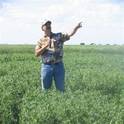
Management practices may influence dryland soil N cycling. We evaluated the effects of tillage, crop rotation, and cultural practice on dryland crop biomass (stems and leaves) N, surface residue N, and soil N fractions at the 0–20 cm depth in a Williams loam from 2004 to 2008 in eastern Montana, USA. Treatments were two tillage practices (no-tillage [NT] and conventional tillage [CT]), two crop rotations (continuous spring wheat [Triticum aestivum L.] [CW] and spring wheat-barley [Hordeum vulgaris L.] hay-corn [Zea mays L.]-pea [Pisum sativum L.] [W-B-C-P]), and two cultural practices (regular [conventional seed rates and plant spacing, conventional planting date, broadcast N fertilization, and reduced stubble height] and ecological [variable seed rates and plant spacing, delayed planting, banded N fertilization, and increased stubble height]). Nitrogen fractions were soil total N (STN), particulate organic N (PON), microbial biomass N (MBN), potential N mineralization (PNM), NH4–N, and NO3–N. Crop biomass N was 30 % greater in W-B-C-P than in CW in 2005. Surface residue N was 30–34 % greater in NT with the regular and ecological practices than in CT with the regular practice. The STN, PON, and MBN at 10–20 and 0–20 cm were 5–41 % greater in NT or CW with the regular practice than in CT or CW with the ecological practice. The PNM at 5–10 cm was 22 % greater in the regular than in the ecological practice. The NH4–N and NO3–N contents at 10–20 and 0–20 cm were greater in CT with W-B-C-P and the regular practice than with most other treatments in 2007. Surface residue and soil N fractions, except PNM and NO3–N, declined from autumn 2007 to spring 2008. In 2008, NT with W-B-C-P and the regular practice gained 400 kg N ha−1 compared with a loss of 221 kg N ha−1 to a gain of 219 kg N ha−1 in other treatments. No-tillage with the regular cultural practice increased surface residue and soil N storage but conventional tillage with diversified crop rotation and the regular practice increased soil N availability. Because of continuous N mineralization, surface residue and soil N storage decreased without influencing N availability from autumn to the following spring.
- Crop residue nitrogen,
- Labile nitrogen fractions,
- Management practices,
- Nitrogen cycling,
- Nitrogen storage
Available at: http://works.bepress.com/andrew_lenssen/26/
